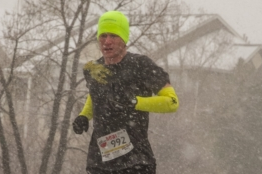For races, it’s helpful to check out a course map and an elevation profile ahead of time, if they’re available. Especially with hills it’s useful to know where they are, even if they’re gradual or barely discernible, so you can strategize appropriately.
In a couple of 5Ks I’ve run, though the area didn’t look hilly, the third mile was significantly net downhill. I didn’t realize this for one of them and when I crossed the two-mile mark behind my goal pace I was close to spent, figured I was toast, and kept up at a reasonable pace, focusing on keeping my place. However, with a quarter mile to go, I realized I was back on pace and it turned into a mad dash for the finish.
In the other 5K example, I knew the profile ahead of time. For that race, my first two miles were a little slower than my goal pace but I was able to pour in some speed on a long downhill stretch in the third mile towards the finish, and I hit the time I planned on.
Understanding the terrain profile is also useful for training runs. When I did a 4X800 speed workout several weeks ago, the first and third 800s were net uphill and the second and fourth were net down. I put a lot of energy into the second 800 and went well under my goal time of 2:59, hitting a 2:53. This likely prevented me from hitting all four in 2:59 or faster. I pushed hard to keep number three at 2:59 and for the fourth one, I was so out of gas that I got 3:01. The purpose of the speed workout is to maximize effort and I wasn’t far off of my planned pace. However, it was a good lesson that while the downhill gave me an advantage, I probably gave too much too early. One could argue that the six seconds I gained on number two compensated for the two seconds lost on number four, but maybe not. On the same route three weeks later, I held back a little on #2 hitting it in 2:59. #3 was 2:57, #4 was 2:53. More miles and speed work between the workouts probably had something to do with the faster overall times but going too fast early in the run does have an impact.
So how do you balance pushing hard with hills, even subtle inclines or declines? I don’t think there’s a magic formula. For my own training and racing, on downhills I let gravity do a lot of the work, especially on the first half. If I’m in the second half, I’ll push harder on the downhills. Up is tricky. I keep an eye on my watch and try to make sure I’m not falling too far off my pace but also not clobbering my legs and lungs too early. Any time gained could be offset by depleting your body. Towards the end, especially within the last quarter mile, boosting my effort up a hill may be necessary, either to snag the good time or stay ahead of the next competitor.
My approach is to understand the terrain and attempt to maintain patience. Doing so goes a long way to making my energy output as efficient as possible and minimizing my time on the course.

Running anecdotes, running food reviews, some race coverage, and more